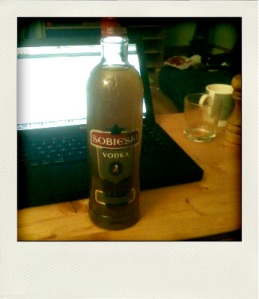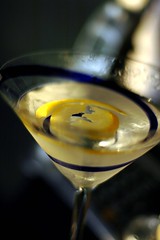24hr Project: Homemade Krupnik
 Krupnik is one of those products that see in tons of bars, but keeps a low profile. It's got a really old school label, straight out of Eastern Europe - appropriately, it's hugely popular with Edinburgh's growing Polish community - but people only seem to know two things: a) it's vodka based, and b) it's honey flavoured.
That's not even unhelpful.
Krupnik is one of those products that see in tons of bars, but keeps a low profile. It's got a really old school label, straight out of Eastern Europe - appropriately, it's hugely popular with Edinburgh's growing Polish community - but people only seem to know two things: a) it's vodka based, and b) it's honey flavoured.
That's not even unhelpful.
It is a tasty product, though, and a recent article on money-saving Christmas gifts in the Guardian got me thinking.
Bottle some Krupnik
Give a bottle of home-made Christmas Krupnik. Henry Besant, founder of worldwidecocktailclub.com suggests this recipe. Buy a bottle of the best Polish vodka you can afford and pour the contents into a saucepan. Add 500ml of runny honey, 2 cinnamon sticks, 3 cloves, a teaspoon of grated nutmeg and an opened vanilla pod and heat gently until the honey is completely dissolved. Simmer for 20 minutes (but do not allow it to boil). Let the mixture cool and then strain it through muslin into a bottle of your choice. Decorate with ribbon and a cinnamon stick around the bottle neck, and add a tag with a serving suggestion, such as: "Serve with warmed cloudy apple juice and a dusting of nutmeg; add a dollop of double cream for a richer alternative."
Not only does this make a handy gift, it's just about perfect for the upcoming spice-themed MxMo. Coaxing the flavour from spices into room-temperature liquids can be troublesome, so getting that flavour extracted before kickoff could be awesome. Another bonus is the simplicity of the recipe - no macerating citrus peels for two weeks, people; instant results!
 I opted for the above recipe, more or less verbatim. The thing I changed was the honey. In the end, I used three different varieties: acacia (light, floral), manuka (heavy, medicinal) and blossom (somewhere inbetween). The acacia honey keeps its liquidity naturally, so I picked a 'runny' pack of the blossom, leaving the heavier, more solid manuka to provide some bass. The other key ingredient was, of course, the vodka. I already had a bottle of Sobieski Vodka on a shelf thanks to an old colleague, and not being a prolific vodka drinker, it wasn't doing much.
I opted for the above recipe, more or less verbatim. The thing I changed was the honey. In the end, I used three different varieties: acacia (light, floral), manuka (heavy, medicinal) and blossom (somewhere inbetween). The acacia honey keeps its liquidity naturally, so I picked a 'runny' pack of the blossom, leaving the heavier, more solid manuka to provide some bass. The other key ingredient was, of course, the vodka. I already had a bottle of Sobieski Vodka on a shelf thanks to an old colleague, and not being a prolific vodka drinker, it wasn't doing much.
Making the liqueur couldn't be easier.
- Pour vodka into a largish pan.
- Heat gently and add the honey.
- Add spices (3 sticks of cinnamon, 3 whole cloves, 1.5 barspoons ground nutmeg, 1 vanilla pod).
- Simmer for 20 minutes - don't let it boil; we're not looking for another distillation.
- Strain through muslin, bottle and stick it in the fridge.
 There are things I'm disappointed in: the colour, for one. The blossom honey is pretty dark and combined with the manuka, it makes the whole thing look kinda murky. Still, it shows a lovely amber glow when you hold it up to the light and if I had any skills in clarifying liquids, I'm sure I could clean it up further. I'm also pretty sure that I put too much honey in the mix; the final liqueur is maybe just a shade too sweet for me.
There are things I'm disappointed in: the colour, for one. The blossom honey is pretty dark and combined with the manuka, it makes the whole thing look kinda murky. Still, it shows a lovely amber glow when you hold it up to the light and if I had any skills in clarifying liquids, I'm sure I could clean it up further. I'm also pretty sure that I put too much honey in the mix; the final liqueur is maybe just a shade too sweet for me.
On the plus side, it tastes phenomenal. The first thing that hits is the honey, with all the depth of flavour that comes from the different varieties. That's followed by a strong cinnamon finish, with a hint of cloves lingering around after. I think it might be the manuka, but this batch reminds me a lot more of Drambuie than it does of Krupnik. That's not a bad thing. Not bad at all.
Update: turns out my two concerns may have been related. After sitting for a couple of days, the liqueur separated, leaving a thick greyish-brown sediment at the bottom and a lovely, clear, amber liquid at the top. That suggests that I either saturated the mixture with the honey or didn't heat it thoroughly enough to dissolve all of it. Given the sweetness and that I didn't use the 500ml specified in the original recipe (I used nearly 350-400ml), I'm going with the former. It's still incredibly sweet, which isn't necessarily a problem, but it's looking way better.




